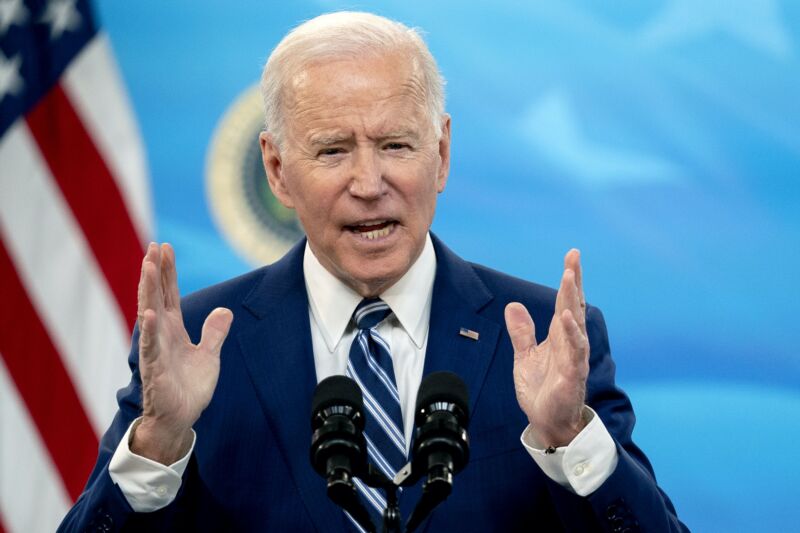Charm, goodwill, and executive orders —
Sweeping order tries to counter rising corporate consolidation.
Tim De Chant
–

Getty Images | Bloomberg
President Joe Biden announced his anticipated executive order today, and it’s a sweeping document that seeks to counter rising corporate consolidation and foster greater competition in everything from labor markets to mergers, banking, healthcare, device repairs, transportation, broadband, and more.
“For decades, corporate consolidation has been accelerating,” the White House said in a statement. “In over 75 percent of US industries, a smaller number of large companies now control more of the business than they did twenty years ago. This is true across healthcare, financial services, agriculture and more.” (We published a separate article today that dives into the broadband portions of the executive order.)
With the order, Biden appears to be positioning himself as an antitrust champion, name-checking famed trust-buster Teddy Roosevelt. That’s no surprise—his appointment of Lina Khan as chair of the Federal Trade Commission telegraphed that he would be taking an aggressive approach to consolidation and anticompetitive practices.
Labor market overhaul
Some of the order’s broadest and most immediate effects will be felt in the labor market. Biden encourages the FTC to outright ban or substantially limit noncompete agreements in employee contracts. The practice was once largely limited to top executives who were highly paid and had broad insight into a company’s inner workings, but over the years, it has trickled down to prevent employees in a variety of industries from taking new jobs with competitors, including sub sandwich makers, janitors, and summer camp counselors.
The practice also pops up in the tech industry, and while many noncompete clauses may not hold up in court, their presence can have a chilling effect, leading many prospective job seekers and potential employers to err on the side of caution. Some states, like California, refuse to enforce noncompete clauses, and others, like Massachusetts, have enacted legislation recently that prohibits the practice. Congress has attempted to step in, with senators proposing similar bans.
The order also encourages the FTC to use antitrust laws and regulations to prevent employers from collaborating to suppress wages or reduce benefits, which is often done by sharing wage and benefit information with each other. Biden is pushing the FTC to restrict “unnecessary occupational licensing” that can create barriers to entry—sometimes costly ones—for people seeking to enter a new field.
Pushing back on platforms
Following the trend of growing antitrust sentiment, particularly of Big Tech, the Biden administration said it would be closely scrutinizing mergers, “especially by dominant Internet platforms, with particular attention to the acquisition of nascent competitors, serial mergers, the accumulation of data, competition by ‘free’ products, and the effect on user privacy.” The order also encourages the FTC to create rules that would regulate the gathering and use of personal information and related data.
When the White House previewed the order earlier this week, they said they would be taking steps to give consumers more latitude in how they repair cell phones and tractors, and those steps are present in the new executive order. Though tractors and mobile phones may seem like an odd couple, they’ve both been at the heart of the right-to-repair movement that has sprung up over the last decade. Farmers have been pushing back against EULAs imposed by equipment manufacturers like John Deere that require authorized technicians for repairs. And tech enthusiasts have been lobbying for the ability to execute DIY repairs or to select independent repair shops to fix broken phones and more. This order promises to make right-to-repair more accessible and enforceable.
Other changes
The rest of the order is a bit of a grab bag, covering banking, airlines, and rail transportation, among others. With respect to banks, the White House is encouraging the Department of Justice and other bank regulators to more closely scrutinize mergers, and it’s urging the Consumer Financial Protection Bureau to issue rules that will guarantee customers downloadable access to their records.
For airlines, the new order attempts to rein-in fees, which have taken off in the last decade, rising from $1.2 billion in 2007 to over $35 billion in 2018. Airlines will have to clearly disclose baggage, change, and cancellation fees, and they’ll have to refund those fees when services aren’t delivered—if baggage is delayed, for example, or if the in-flight Wi-Fi is broken.
Passenger rail also gets a boost under the order. The president, who has been nicknamed “Amtrak Joe,” is pushing the Surface Transportation Board to force freight train companies and other track owners to follow through on the rights of way that passenger trains are supposed to receive. Amtrak, which had typically settled disputes with freight companies quietly, has grown increasingly vocal in recent years about the problems it has had with delays caused by freight trains. By law, Amtrak trains are supposed to be given preference, but in practice, that’s not always the case. Biden’s executive order could help Amtrak get its trains back on time.
“Encouraging” order
Many parts of the executive order “encourage” different agencies to take action. There’s a reason for that—though the document is called an “order,” the president cannot force independent agencies, including the FTC, FCC, and others, to follow his every word. “The executive cannot make an agency do anything, because we do not have a command-and-control government,” Shane Greenstein, a professor at Harvard Business School, told Ars. “The executive branch does not even make the budget. It just proposes one, and Congress takes it apart and makes its own. It can only hire and fire the people at the top of an agency—and even then, its ability to fire is pretty limited.”
“So what does the executive branch have? Its charms and goodwill. Its executive orders,” he added. “Since it is still early in the administration, most political appointees will want to play nice. And in any event, most of them largely agree with the general direction, albeit, perhaps not the details and specifics.”

